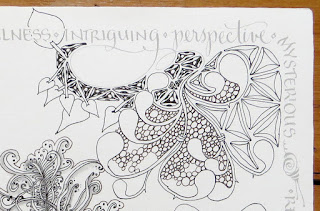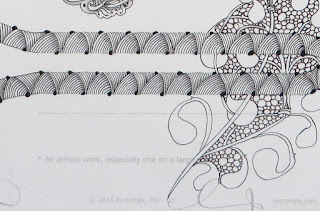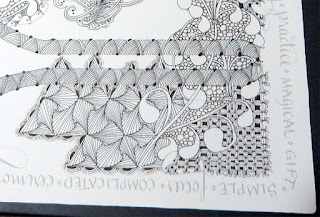In 2007, we started BLOG Zentangle and began our enjoyable series of conversations within our Zentangle community.
In reading through these blog posts with their insightful comments, we decided to bring a few of them to your attention from time to time. It is easy, for me anyway, to sometimes think of old information as stale information. But these insights and conversations are anything BUT stale!
We invite you to enjoy this post from 2015...
Begin previous post . . .
Rick begins:
This morning at breakfast I heard Maria laugh. "You have to read this," she said. And with a big smile, she handed her computer to me. I began to read an email from Lesley Roberts, CZT, in UK:
. . . I have stopped teaching my Zentangle courses for July and August now, and they will begin again in September. At the last classes I showed my groups Opus tiles [10.5 inches, 27 cm square], to see if they might like to have a go at tangling on them, slowly, under no pressure, over the summer break. The reactions varied – from sheer excitement to anxiety.
At the first class I showed the blank Opus tile, someone admired the back of the tile and said it was a shame that the inspiring words were not on the front of the tile as they would make a great border around the tangle.
Well, that was all the inspiration I needed! I immediately began my tangle on the back of the tile. I wanted to show them that you can just begin with no plan. I tangled – spontaneously and happily for between 2 - 3 hours a day for 8 days until the tile was complete. I shaded as I went for while, then decided to leave it all till the end, so I did not lean across the shading and smudge it.
I took photos along the way of creating it, as I knew I’d want to share them with students later on, and I’d never otherwise have remembered how I did it.
The first photo attached is taken by Martin, and I thought you might like to see it.
I began to realise – from a teaching and learning perspective that all I’ve seen so far on the Internet are completed Opus tiles – lovely, amazing, awesome ones – but possibly very off-putting to those who have not worked that scale before, so I thought you might like to see all the stage by stage photos – for yourselves, and maybe to share them with a wider audience, if you think that might be valuable.
Sorry it’s such a long email, but I so, so enjoyed tangling the back of the Opus tile . . . and was very happy with the process and the end result. I limited the number of different tangles, and found that I kept creating variations of tripoli, on different scales – it seemed to bring it together for me.
I also liked the opportunity to tangle both on a very large and very small scale, it seems to add balance. Anyway, bye for now – have a lovely weekend. [. . .]
I said to Maria, "Let's do a blog post on this, today!"
Maria sent her an email and Lesley wrote back:
I would be very happy for Rick to do a blog about it – and very honoured.
I think that Opus tiles offer up so many opportunities to tangle in new ways, yet it is that bigger freedom and scale and possibilities which are so fearful for many people that they don’t know how to begin, so they don’t even go there.
In strange ways the Zentangle process – no mistakes, focus only on the one stroke you are drawing, no need to seek perfection – holds even more true than ever. I had thought it might be the opposite until I tried it out. If you were to look ahead at all the tangling to come, you might not do it! So you really have to be in the now.
Maria continues:
We are so grateful to Lesley for taking the time to put her experience into words for us all.
To see someone take something so simple as a Zentangle tile and use it like this in a completely unexpected way is invigorating. I love the way Lesley used the flourishes of my calligraphy for her border and then began with some pretty large tangles and used them to establish an inherent string.
It just goes to show, there is always something new to learn on this Zentangle adventure.
Rick comments:
Lesley sent more in-progress photos:
In this enlargement of the above photo you can see what Maria was describing about Lesley using her flourishing as border:
In this next enlargement of the same photo, notice how Lesley took inspiration from some of the printed elements, such as the horizontal lines, and totally ignored others, for instance, the typeset words:
Notice how Lesley continued to use the hollibaugh method of drawing behind to layer her tangles one behind another and how the text basically disappears under paradox:
Maria continues:
This is also a great reminder for all of us to be receptive for new opportunities, whether a fleeting image or a casual comment such as Lesley heard.
In my life, it has always been my children that teach my most profound life-lessons. And now, our compassionate students join them to guide us through this world of Zentangle discoveries . . . through their comments and their art.
We listen, learn, and evolve.
So, dear Tanglers, have you learned something you'd care to share with us about Zentangle ideas that perhaps came from a student or friend, that enabled you to the see impossible/improbable/crazy/unthinkable ideas that shape your art?
We'd love to hear your stories.
-----+-----
Many thanks to all for this glorious journey.
R&M








Henrike Bratz, CZT on
Keep up the awesome work!
Hugs & ciao
patsy
patsy monk CZT 2 on
Thank you for dusting off these older posts. I can’t remember if I read this one at the time, but even if I did it was wonderful and worthwhile to read again. Breaking a tile down into more manageable bites is such a great metaphor for so many of life’s challenges. I’ve never tackled an Opus and doubt I ever will, but I have broken down larger tangling projects into smaller sections, which makes them less daunting and also prolongs the pleasure. Who wants to rush a good thing!
Jem Miller on
MaryAnn Scheblein-Dawson, CZT#1 on
Wow! I remember the anxiety I felt when I got my first order of Opus tiles. My first thought was , “egad! How will I ever start!?” and I really didn’t want to because I was so concerned about ruining the tile. My, what a very short span of time can do. And mixed in there, getting my CZT. Spending time Tangling and learning from the creators and masters at Seminar #31 boosted my confidence and spirit for adventure in a way nothing else could have. It wasn’t a week after getting home from Providence that I got out that first Opus and just started Tangling. I wish I had seen this post beforehand as it would have helped me feel more courageous in breaking it all down and using the text on the back as a string and border. I think that’s something I will definitely do from this day forward with my students. It takes so much of the fright out of it. You folks at the heart of this wonderful experience simply mustn’t underestimate the benefit of spending time working with you. You are all magical in my world!
Rita Miller on
Carol Johns on
Well, what a lovely surprise to wake to an email this morning from Dawn Hayward, a UK CZT I met on Sunday for the first time, pointing me in the direction of this blog! Even I have enjoyed re-reading the blog and reminding myself of what I drew!! ….. And I realise that everything here that either I wrote, or Maria and Rick wrote, about the Zentangle process and about learning holds true from nearly 4 years ago. I am also reminded, reading the comments from the teachers who attended my class at Tangle U 2016, which this blog led to, of the amazing moment when around 74 teachers held up their Opus tiles which they had been tangling on for a couple of hours and smiled …… They had at last begun their Opus journey!! Thank you so much, Rick and Maria, for sharing this old post
Lesley Roberts on
Hazel on
I love this post! I took an Opus class from Lesley at TangleU in which she talked about helping our students to overcome their fear of such a gigantic piece of lovely BLANK paper! Many of us CZTs needed to hear her suggestions for ourselves as well. :) I think many MANY hours of unjudged tangling experience is immensely important to inviting most tanglers to “go big”. Add to that the philosophy of “no mistakes” and playing the “what if” game and I find I am unable to resist an invitation to draw on almost ANYthing! I have also observed some of my students now have the confidence to just dive in and see what happens. That’s my goal for every student in every class! When my Zentangle Club gathers 3 times/month, I notice that those who are more timid are usually inspired by those who are more bold. And that encourages us all!
Jan Brandt, CZT 12 on
In the present day, this Opus tile could have been considered a “traveling tile.” Maria started with the border and sparse center, Lesley finished with her awesome tangling. Love these collaborative activities.
Linda M Dochter, CZT on
LouAnn Smith on
Gloria V on
Thank you Rick and Maria. I do remember that first blog post as an aha! moment, and it was just as great seeing the
post again today. I’ve been in an art funk for a couple of weeks (too many projects, spring just won’t arrive, projects partially done and just no creative bent to finish them) but the blog reminder as well as the “What If” game, gave me the necessary inspiration to get in the art room and create. Thank you for the creative boost!
Sherri Lee, CZT7 on
Kate Ahrens CZT IX on